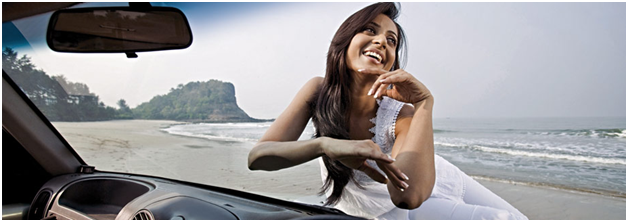Plug-in window
Flush fitted glass is a new concept in the Indian market. Two glasses assembled and fitted as exposed flush glass. One fixed glass directly glued to vehicle body while the other fixed glass moves on the first glass with help of upper and lower rails. When the second glass moves above the upper glass, a window is created.
Solar Control Glass
Laminated Glass with increased iron content absorbs infrared rays and reduces the amount of heat in the car. This helps in:
- • Reducing the solar energy entering the car
- • Preventing the rise of interior temperatures
- • Reducing the load on the air-conditioning, thereby reducing fuel consumption
- • Reducing cool-down time after sun-soaked conditions
- • Reducing skin irritation caused by sunlight
PET Windshield
It is a laminated windshield with an Optically Clear Polyester (PET) substrate. Also, silver and metallic oxides are sputtered to create spectrally selective filters for solar control. PET Windshields help in:
- • Improving the visibility
- • Resists break-in’s
- • Reducing interior heat load
- • Increasing fuel efficiency
- • Potential weight & costs savings
- • Reducing emissions
- • Clear Solar Control (IR-Reflecting)
- • Reducing noise
- • Reducing UV
Rain Sensor Windscreen
Rain sensors save a driver from the constant distraction of having to flick the wipers to adjust the blade speed. A sensor at the base of the wipers detects the volume of rain falling on the windscreen and accordingly adjusts the speed of the wipers. It uses two types of sensor – the acrylic fiber system that bonds a bracket for the sensors to the glass and the silicon system which bonds the sensor lens to the glass.
Heated Windshield
Driving on winter mornings can be quite daunting especially after heavy snowfall. Our heated windscreens have heat conductive patterns at the base near the wipers which melt the snow along the bottom of the glass and free the wipers to remove snow, and ice.
Water Repellent Glass
When rain pelts down, or a passing vehicle splashes up water on the car, forming a distorting translucent sheet on the glass surface, visibility can be dangerously low. To remedy this, our water repellent glass has a special polymer coating which does not allow water droplets to adhere to the surface. Water droplets are disallowed to spread and retain their spherical shape. These tiny pearls of water are easily blown away as the car increases speed, leaving the glass panel clear and clean. It is easy to clean as it resists dust and dirt. It requires little maintenance and is highly durable.
Extruded Windscreen
At SGI we believe in providing holistic solutions, which is why we have now developed extruded windscreens. Extruded windscreens are fixed with a molded rim of PU/TPE that is bonded with an adhesive. This forms an aesthetic lining along the edge of the glass, and allows Original Equipment Manufacturers to fix windows to automobiles bodies in one convenient simple step.
Acoustic Glass
Acoustic glass uses multi-layer co-extruded Acoustic PVB. It addresses the fundamental performance problems of glass with respect to noise transmission - Resonant vibrations and Coincident effect.





